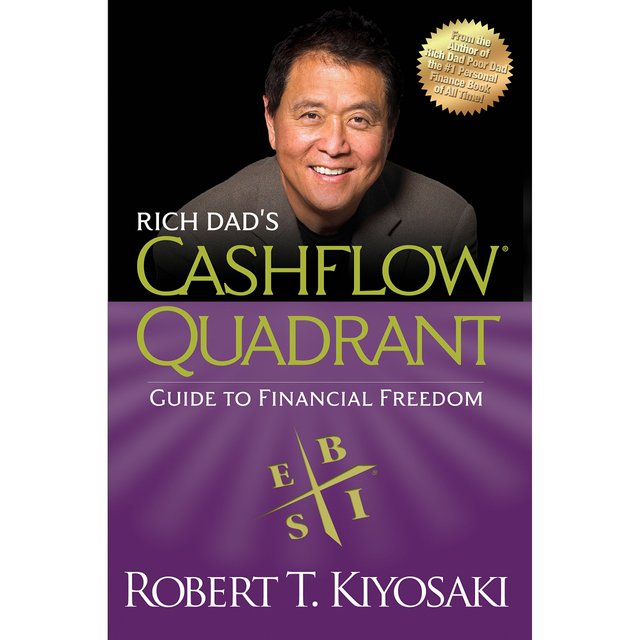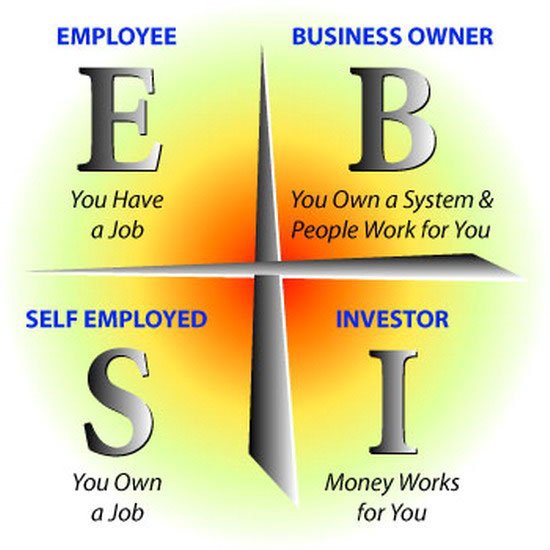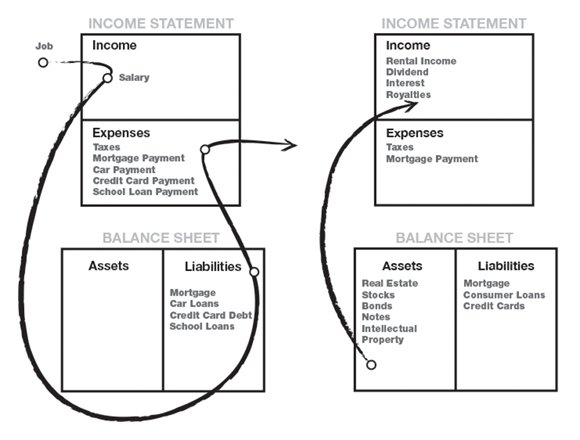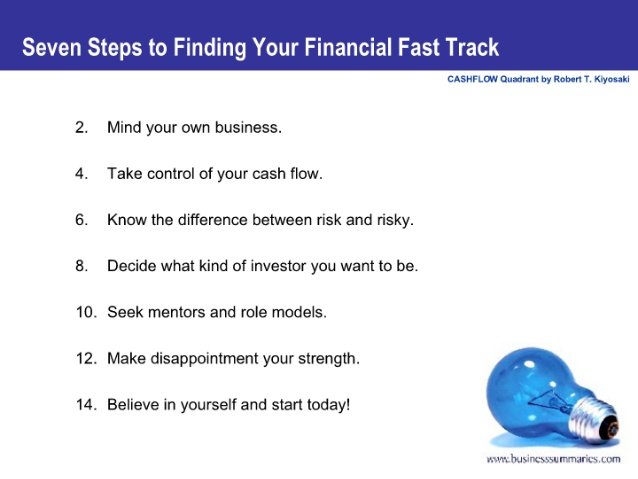Book Review - Rich Dad's Cashflow Quadrant - Robert Kiyosaki
I've read that one of the best ways to truly comprehend the most valuable lessons of a book is to write down what you've learned that was most relevant following the completion of the book. I have decided to put this idea to the test and will be reviewing the books that I read individually upon completion of each book. I'm hoping that this will allow me to comprehend and retain more of what I read as well as give my readers a helpful summary by synthesizing what I believe to be the most relevant takeaways from each book. Follow @brandonp if you are interested in receiving updates on these books as I post my reviews.
Rich Dad's Cashflow Quadrant

Many people are familiar with the personal finance best seller Rich Dad, Poor Dad by Robert Kiyosaki. While I also own that book, I actually decided to read this one first based on a recommendation from a guest on the BiggerPockets podcast who attributed much of his financial success in real estate to both Cashflow Quadrant and Rich Dad, Poor Dad. I decided to pick up Cashflow Quadrant because I have really been getting into investing in real estate and learning a lot more about that sector. As few of you know, I am a mortgage broker currently and own my own home, but this book flipped the idea of owning a home on its head for me. Not that a primary residence is necessarily a bad investment, but just the way that one should go about thinking about real estate and investments in general. I'm getting ahead of myself here though, so I am going to go back a few steps.
The Cashflow Quadrant
The basic premise of Cashflow Quadrant comes from an actual symbol of a quadrant with various letters in it.

Each letter corresponds to a different way in which money and wealth is earned. The "E" is for employee, in which you are work for someone else. "S" stands for self-employed, where you work for yourself. "B" is for business, where you build a system to employ others. And finally, "I" is for investment in which your money works for you. Most people start on the left side of the quadrant and a vast majority of them stay there for their entire lives. Kiyosaki's point is that you should want to move to the right side of the figure if you truly want to be rich.
Part One
The first part of the book is primarily explaining the different quadrants and the people who occupy those quadrants. I am currently in the "E" quadrant as I receive most of my money from my employer. I also have aspects of my life that are in the "S" quadrant in that I write for Steemit and coach volleyball. My personal hope is to move to the "B" and "I" quadrants where I can have my money work for me and not work for money. In order to have true financial freedom, one must move from the left side of the quadrant to the right. My simplest way to think of it is that the left side is where you trade time for money, and the right side affords you the ability to trade money for more money. Obviously, based on this definition the right side is way more attractive.
Another major point of note here is the differences in the looks of an individual's income statement and balance sheet.

On the left hand side we see the income statement and balance sheet of someone on the left side of the cashflow quadrant, while on the right side we see the financial statements of someone in the "B" and "I" quadrants. On the left, there is little or no building up of assets and much of one's income goes towards liabilities and expenses. On the right side of the quadrant, you would produce much of your income through assets that produce cash flow. You still have liabilities and expenses, but these are more than made up for with the income produced by the assets.
This is what fascinated me and drew me into reading and studying this book carefully. It was a truly mindset shifting experience to see these simple financial statements. The idea that each liability and expense is an asset and income for someone else was mind blowing. I had honestly never thought of my own finances in that way. At this point I was all in on moving from the left side to the right side of the cashflow quadrant.
Part Two
The second part of Cashflow Quadrant primarily deals with the mindset shifts that are required to journey from one side of the quadrant to the other. This is one of the most important aspects of the book as anyone can understand the the numbers and be enamored by the prospects of financial freedom, but there is a strong mental barrier to truly break through to the right side of the cashflow quadrant.
The fact that we are taught in school to avoid making mistakes, to memorize solutions to easy problems, and absolutely nothing about personal finance already puts every single one of us at a disadvantage. School prepares us to fit into the "E" and "S" quadrants, but teaches us nothing of the "B" and "I" quadrants. Even as someone who attended and did well in business school, I found myself learning something new on every page. While I am obviously not at the point where I am ready to just quit my job as an employee and begin building businesses, this book certainly laid the foundation for that to be a potential option in the future.
One of the biggest takeaways from Cashflow Quadrant was the idea that money is seen through the mind and not the eyes. What this means is that many of us have a skewed understanding of money and our own personal finances. We often value security over potential reward such as "safe" investments like 401k's and diversified stock portfolios. I do deviate a bit from Kiyosaki in that I believe there is a place for diversified portfolios, but I do agree that they are touted as the gold standard when really they are simply a small drop in the investment pool. Bigger returns with less risk can be found out there.
Lastly, Kiyosaki talks about being the bank and not the banker. As the bank, you own assets that show up as liabilities to others. Even your own liabilities should be paid by others (rental properties when it comes to real estate). No investment should ever be cashflow negative, but truly what one must understand is the mindset that goes along with thinking about money in terms of assets and liabilities. One must see through much of the complicating jargon that typically accompanies investment products and see to the bottom of the line. Is it an asset that will produce cashflow, or is it a liability that will suck money from your pocket and spit it into the pockets of others? Answering this question is not always as easy as it may seem.
Part Three
Finally, in part three of Cashflow Quadrant, Kiyosaki gives seven actionable steps to move you from the left to the right side of the cashflow quadrant.

These seven steps are extremely important on the cashflow quadrant success journey as you might imagine. Following the steps should in theory move you from the left to the right side of the cashflow quadrant. My hope is to work on this and eventually move from my current position as an "E" to that of a "B" and "I". At that point, I would be able to achieve financial freedom and stop trading my time for money and start making my money work harder for me.
Conclusion
Overall, I thoroughly enjoyed reading Cashflow Quadrant and highly recommend it to anyone who hopes to one day achieve financial freedom. Learning and studying the quadrant is helpful because it gives a visual representation of different sections of humans in the workforce. It also forced me to dig deep into what I want out of my career and where I want to be in terms of the cashflow quadrant. My desire is to move from the left side to the right side and begin earning my income from assets as opposed to as an employee of a business that reaps the benefits of my own hard work.
My goals are to invest in real estate rental properties in order to begin building my balance sheet with assets as well as liabilities that others pay for. While I know this will not be easy by any means, I feel I have gained a solid foundation in the thinking of money in a way that will be beneficial to me in the future. Embracing the mantra of "be the bank, not the banker" will be something that forces me to continue to approach money with my mind and not my eyes.
Recommendation: Highly Recommend!
If you enjoyed this book review, please consider following @brandonp for more book reviews in the future. Don't forget to resteem and upvote so more people can see this post!
Robert Kiyosaki has a way of making you think. If you get the mindset that he is cultivating in his books then you will like all his books. There are many bad reviews of his books and those are written by people who just cannot create a mindset that is needed to absorb the information - that will actually make you rich, if you follow the advice. There are hundreds of thousands of people who regard Robert as their mentor.
Very good review and deserves and upvote. Following!
Thank you @maxabit. I completely agree with you in regards to the mindset that Kiyosaki cultivates in his books. I always try to take reviews with a grain of salt because there tends to be a bias toward the ends of the spectrum. Most people don't review a book that is just average, but many will post scathing or raving reviews because that incites action.
Thank you @brandonp for this lovely post. It was very informative and I'm looking forward to more book reviews in the future. This is a great topic to cover too as it can potentially help all of your followers.
One question I had was on Point 6. Know the difference between Risk & Risky. Can you please elaborate a little on this?
I don't have the book in front of me to give you exactly what Kiyosaki says, but there are a couple aspects to this point. First is that one must know the difference between risk and volatility. Just because the value of an asset fluctuates day to day does not mean it is necessarily risky, just volatile. Second, one must realize where the risk in an investment actually is. In the case of a rental property, there is financial risk to the owner, but this is mitigated by the fact that the mortgage is paid via rent from the property. This is probably a terrible elaboration, but that is how I took it.
I see. Thanks for the explanation. I was trying to compare risk vs. risky to crypto currency which is one of my latest investments that's why I asked. Crypto seems like its very volatile. Whales seem to have a good control over the market and really dictate which direction coins go.
Another huge aspect of the "risk vs. risky" point is about financial literacy, but if you broaden it to just mean "knowledge" then it fits a little better. One of the reasons investments are risky is because of the fact that people tend to lack the knowledge to truly understand and fully comprehend the investments they are taking positions on. In terms of crypto let's put it this way: I don't invest in other crypto's because I don't have nor do I ever plan to have the knowledge necessary to give me a leg up on the competition. I've been on Steemit and understand it enough that I feel I have the knowledge to do on average better than the typical person on the platform.
You have NEW follower. I've read Rich Dad and Retire Rich and they both touch on this, quite interested. #thealliance likes your style ;)
Glad to hear that I have #thealliance on my side!
Thank you for sharing review of this book. Like millions around the world I too read Robert's Rich Dad book and it is a great one. I will try to read this one too.
Thank you.
Glad you enjoyed the review. I still have yet to read Rich Dad Poor Dad so that will certainly be coming up soon.
Great Post, This is one of my favorite book among the robert kiyosaki next to
I also recommend this one as well, they sum up all the book in this audio I listen to it all the time
I am a big fan of Robert Kiyosaki, he teaches us what we didn't learn in school.
Very nice article & review. upvoted
Excellent break down of the book. I will have to check it out on Kindle.
If you do a lot of book reviews I recommend that you sign up for Amazon affiliates. You can then put a link to the book on Amazon and earn a small commission. Book commissions are very low about .25 cents to $1.00 USD. I have some posts that talk about that. Hope this helps.
I am a newbie here and like the great feeling of community that I see here on Steemit.
I write a lot about how powerful one's mindset can be. I also talk about different ways to make money online as an entrepreneur.
Would love to get your thoughts on it.
Mindset of time for money
Thanks you rock.